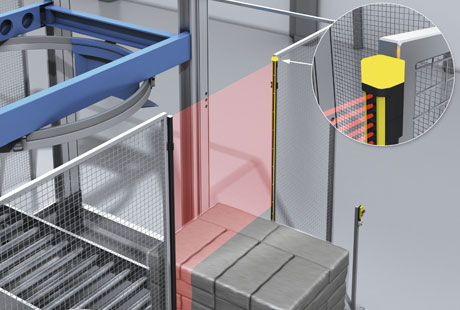What Is The Function Of The Light Curtain?
Key Takeaway
The primary function of a light curtain is to enhance safety in industrial settings by establishing an invisible barrier of infrared light around hazardous machinery. When these light beams are interrupted by an object, such as a person’s hand, the light curtain swiftly sends a signal to shut down the machine. This immediate action prevents accidents and injuries by halting the machine’s operations before harm can occur.
If the interruption is cleared and the area is deemed safe, the system can be reset to resume normal operations. This vital safety mechanism protects both personnel and equipment, ensuring a secure working environment.

What is a Light Curtain?
A light curtain is a safety device used in industrial environments to detect the presence of persons or objects in predetermined areas, thus preventing access to dangerous zones. Composed of numerous photoelectric beams spaced closely together, these curtains create an invisible safety barrier around hazardous machinery. When any of the beams are interrupted, the system reacts instantaneously, a crucial feature designed to offer both safety and operational efficiency.

Primary Function: Personnel Protection
The primary role of light curtains is personnel protection. Strategically installed around areas prone to accidents, such as robotic arms, press machines, or conveyor belts, light curtains act as invisible protective barriers. The instant interruption of the light beams by any intrusion triggers a halt in the machine’s operation, providing a crucial safety measure that prevents workers from coming into direct contact with dangerous parts of machinery.
You May Like to Read
Machine Interruption Mechanism
The effectiveness of light curtains hinges on their rapid response machine interruption mechanism. When the aligned beams of light are broken, the system’s sensors detect this disruption and communicate directly with the machine’s control unit. This communication prompts an immediate shutdown of the machine’s operations, effectively minimizing the risk of injury. The system’s ability to react in milliseconds is a critical feature that ensures the safety of workers in high-risk environments.
Integration with Control Systems
Integration with existing control systems enhances the functionality of light curtains. By connecting to the broader factory automation system, light curtains can not only stop machinery but also log data regarding the incidents and interactions. This capability allows for better analysis of frequent interruptions or near-miss events, enabling further improvements in safety protocols and preventive measures. Additionally, this integration facilitates seamless operations by allowing the safety system to communicate with other parts of the production process, ensuring that safety measures do not unduly interrupt productivity.
Benefits Over Traditional Safety Measures
Light curtains offer several advantages over traditional safety measures like physical guards or manual safety checks. They provide a high degree of flexibility and do not physically obstruct the work environment, allowing for better visibility and easier access when safe. Furthermore, because light curtains are adjustable and programmable, they can be set to different heights and sensitivities, accommodating various types of machinery and operations. This adaptability makes them ideal for dynamic industrial settings where conditions and configurations might frequently change.
Conclusion
Light curtains are a important component of modern industrial safety systems. Their ability to provide immediate and reliable protection for personnel without hindering operational efficiency makes them invaluable in today’s fast-paced industrial sectors. For engineers and safety professionals, understanding and effectively implementing light curtains are crucial for ensuring that safety measures keep pace with technological advancements in manufacturing and processing industries. Their continued development and integration into industrial safety protocols reflect a commitment to leveraging technology not just for productivity but importantly, for the well-being of workers.
